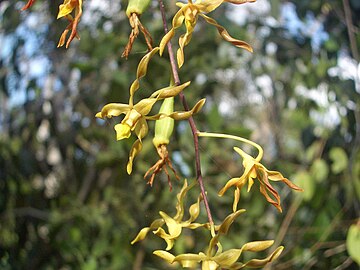
Dendrobium antennatum, commonly known as the green antelope orchid, is an epiphytic orchid in the family Orchidaceae. It has cylindrical pseudobulbs with up to twelve leaves near their tips and up to fifteen white flowers with green petals and a white labellum with purple stripes. It grows in New Guinea and in tropical North Queensland where it is rare.

Dendrobium bigibbum, commonly known as the Cooktown orchid or mauve butterfly orchid, is an epiphytic or lithophytic orchid in the family Orchidaceae. It has cylindrical pseudobulbs, each with between three and five green or purplish leaves and arching flowering stems with up to twenty, usually lilac-purple flowers. It occurs in tropical North Queensland, Australia and New Guinea.
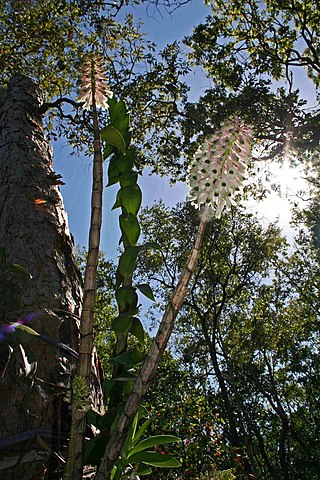
Dendrobium smillieae, commonly known as the bottlebrush orchid, is an epiphytic or lithophytic orchid with large, spongy pseudobulbs, thin, bright green leaves which are shed after their first year and crowded flowers in a bottlebrush-like arrangement. The flowers are white, to cream-coloured or pink and the labellum has a shiny, dark green tip. This orchid species is found in some of the Torres Strait Islands, and through Cape York Peninsula to Townsville, Queensland. It is also found in New Guinea and eastern Indonesia.
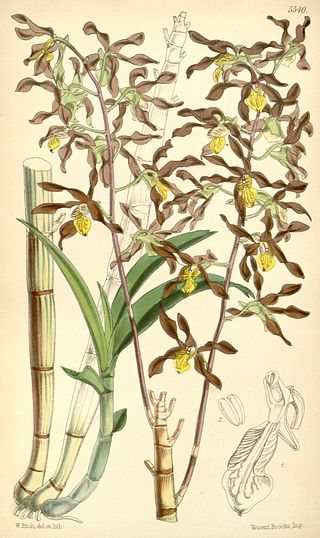
Dendrobium johannis, commonly known as the chocolate tea tree orchid, is a species of epiphytic or lithophytic orchid native to Australia and New Guinea. It has spindle-shaped pseudobulbs, between five and ten dark green leaves with purplish markings and flowering stems with up to fifteen chocolate brown flowers with a yellow labellum.

Spathoglottis paulinae, commonly known as the small purple orchid, is a plant in the orchid family and is native to New Guinea and Tropical North Queensland. It is an evergreen terrestrial orchid with crowded pseudobulbs, between four and seven large, pleated leaves and up to thirty mauve to purple flowers.

Dendrobium callitrophilum, commonly known as the thin feather orchid, is an epiphytic orchid in the family Orchidaceae with narrow pseudobulbs, one or two thin, leathery leaves and up to six greenish yellow flowers with a cream-coloured or apricot-coloured labellum. It grows in or near rainforest in isolated parts of tropical North Queensland.

Dendrobium agrostophyllum, the buttercup orchid, is an epiphytic or lithophytic orchid in the family Orchidaceae and has a creeping rhizome with well-spaced pseudobulbs. Each pseudobulb has up to twenty grass-like leaves, some of the leaves having flowering stems on the opposite side of the pseudobulb, each raceme with up to ten waxy, fragrant, bright yellow flowers. It grows in wet forest in coast areas of north Queensland, Australia.

Dendrobium baileyi, commonly known as the blotched gemini orchid, is an epiphytic or lithophytic orchid in the family Orchidaceae and has arching stems and flowering stems with one or two spidery, yellow flowers with dark purple spots emerging from leaf axis. It grows in tropical North Queensland, New Guinea and the Solomon Islands.
Dendrobium fellowsii, commonly known as the native damsel orchid, is an epiphytic or lithophytic orchid in the family Orchidaceae and has upright pseudobulbs, up to five leaves and groups of up to five pale green or yellowish flowers with a deep purple labellum. It grows in tropical North Queensland.

Dendrobium bifalce, commonly known as the native bee orchid, is an epiphytic or lithophytic orchid in the family Orchidaceae. It has spindle-shaped pseudobulbs with up to four leathery leaves and up to ten pale green or greenish yellow flowers with purplish markings. It grows on trees and boulders in rainforest in tropical North Queensland, Australia and in New Guinea.

Dendrobium canaliculatum, commonly known as the brown tea tree orchid or thin tea tree orchid, is an epiphytic or lithophytic orchid in the family Orchidaceae. It has cone-shaped or onion-shaped pseudobulbs, up to six deeply channelled, dark green leaves and up to thirty star-shaped, light brown to caramel-coloured white or greenish to apricot-coloured flowers with darker tips. It grows in tropical North Queensland and New Guinea.
Dendrobium carrii, commonly known as the furrowed moon orchid, is an epiphytic orchid in the family Orchidaceae and has well-spaced pseudobulbs with one or two leaves, and flowering stems bearing between five and ten white or cream-coloured flowers with an orange or yellow labellum. It mostly occurs on the ranges inland from Cape Tribulation and Innisfail in Queensland.

Dendrobium carronii, commonly known as the pink tea tree orchid, is a small epiphytic orchid in the family Orchidaceae. It has cone-shaped or onion-shaped pseudobulbs, between two and four channelled, green to purplish leaves and up to twelve star-shaped, pink flowers with dark brown and purple markings. It grows in tropical North Queensland and New Guinea.

Dendrobium fleckeri, commonly known as the apricot cane orchid, is a species of epiphytic or lithophytic orchid endemic to far north Queensland, Australia. It has cylindrical pseudobulbs with two or three dark green leaves and up to four apricot-coloured or yellowish green flowers with tangled white hairs on the edge of the labellum.
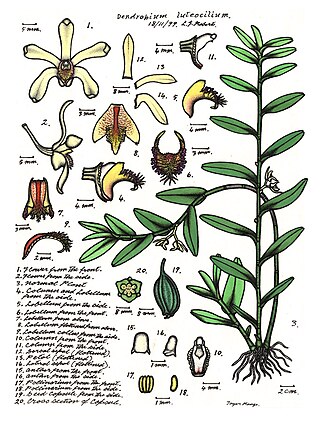
Dendrobium pruinosum, commonly known as the honey orchid, is an epiphytic or lithophytic orchid in the family Orchidaceae and has flattened, yellowish stems and pairs of cream coloured, dull yellow or greenish flowers. It grows in tropical North Queensland and New Guinea.

Dendrobium mirbelianum, commonly known as the dark-stemmed antler orchid or mangrove orchid, is an epiphytic or lithophytic orchid in the family Orchidaceae. It has cylindrical, dark-coloured pseudobulbs with leathery, dark green leaves and up to twelve pale to dark brown flowers with a yellow labellum with dark red veins. This antler orchid occurs in northern Australia, New Guinea and Indonesia.

Dendrobium nindii, commonly known as the blue antler orchid, is an epiphytic or lithophytic orchid in the family Orchidaceae. It has erect, cylindrical, leafy pseudobulbs with leathery, dark green leaves and up to twenty mauve or violet flowers with darker veins on the labellum. This antler orchid occurs in tropical North Queensland and New Guinea.
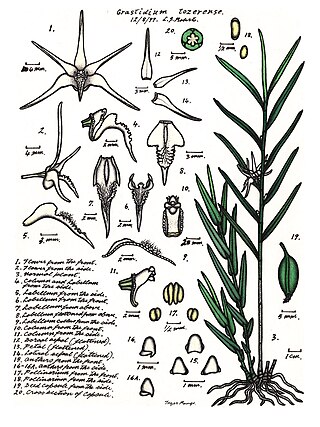
Dendrobium tozerense, commonly known as the white gemini orchid, is an epiphytic or lithophytic orchid in the family Orchidaceae. It has thin, wiry stems, stiff leaves and pairs of star-shaped, white flowers. It grows in rainforest in tropical North Queensland, Australia.
Dendrobium convexum, commonly known as the piggyback orchid, is an epiphytic orchid in the family Orchidaceae. It has a creeping, brittle root, erect pseudobulbs with a single leaf on the top and one or two cream-coloured, short-lived flowers with a red and yellow labellum. It is native to Southeast Asia, New Guinea and tropical North Queensland, Australia.
Dendrobium glabrum, commonly known as the creeping star orchid, is a species of epiphytic orchid native to New Guinea and Australia. It has shiny pseudobulbs with a single leathery leaf and white, star-shaped flowers with yellow tips. It forms large clumps on trees in humid forests.


